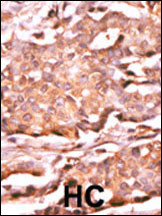Phospho-RAD9(S272) Antibody
Affinity Purified Rabbit Polyclonal Antibody (Pab)
- SPECIFICATION
- CITATIONS: 3
- PROTOCOLS
- BACKGROUND

Application
| WB, IHC-P, E |
|---|---|
| Primary Accession | Q99638 |
| Other Accession | Q4R5X9 |
| Reactivity | Human |
| Predicted | Monkey |
| Host | Rabbit |
| Clonality | Polyclonal |
| Isotype | Rabbit IgG |
| Calculated MW | 42547 Da |
| Gene ID | 5883 |
|---|---|
| Other Names | Cell cycle checkpoint control protein RAD9A, hRAD9, DNA repair exonuclease rad9 homolog A, RAD9A |
| Target/Specificity | This RAD9 Antibody is generated from rabbits immunized with a KLH conjugated synthetic phosphopeptide corresponding to amino acid residues surrounding S272 of human RAD9. |
| Dilution | WB~~1:1000 IHC-P~~1:10~100 E~~Use at an assay dependent concentration. |
| Format | Purified polyclonal antibody supplied in PBS with 0.09% (W/V) sodium azide. This antibody is purified through a protein A column, followed by peptide affinity purification. |
| Storage | Maintain refrigerated at 2-8°C for up to 2 weeks. For long term storage store at -20°C in small aliquots to prevent freeze-thaw cycles. |
| Precautions | Phospho-RAD9(S272) Antibody is for research use only and not for use in diagnostic or therapeutic procedures. |
| Name | RAD9A |
|---|---|
| Function | Component of the 9-1-1 cell-cycle checkpoint response complex that plays a major role in DNA repair (PubMed:10713044, PubMed:17575048, PubMed:20545769, PubMed:21659603, PubMed:31135337). The 9-1-1 complex is recruited to DNA lesion upon damage by the RAD17- replication factor C (RFC) clamp loader complex (PubMed:21659603). Acts then as a sliding clamp platform on DNA for several proteins involved in long-patch base excision repair (LP-BER) (PubMed:21659603). The 9-1- 1 complex stimulates DNA polymerase beta (POLB) activity by increasing its affinity for the 3'-OH end of the primer-template and stabilizes POLB to those sites where LP-BER proceeds; endonuclease FEN1 cleavage activity on substrates with double, nick, or gap flaps of distinct sequences and lengths; and DNA ligase I (LIG1) on long-patch base excision repair substrates (PubMed:21659603). The 9-1-1 complex is necessary for the recruitment of RHNO1 to sites of double-stranded breaks (DSB) occurring during the S phase (PubMed:21659603). RAD9A possesses 3'->5' double stranded DNA exonuclease activity (PubMed:10713044). |
| Cellular Location | Nucleus. |

Provided below are standard protocols that you may find useful for product applications.
Background
Rad9 is highly similar to Schizosaccharomyces pombe rad9, a cell cycle checkpoint protein required for cell cycle arrest and DNA damage repair in response to DNA damage. This protein is found to possess 3' to 5' exonuclease activity, which may contribute to its role in sensing and repairing DNA damage. It forms a checkpoint protein complex with RAD1 and HUS1. This complex is recruited by checkpoint protein RAD17 to the sites of DNA damage, which is thought to be important for triggering the checkpoint-signaling cascade.
References
Maniwa, Y., et al., Cancer 103(1):126-132 (2005). Wang, W., et al., Proc. Natl. Acad. Sci. U.S.A. 101(48):16762-16767 (2004). Lindsey-Boltz, L.A., et al., (er) Nucleic Acids Res. 32(15):4524-4530 (2004). Toueille, M., et al., (er) Nucleic Acids Res. 32(11):3316-3324 (2004). Loegering, D., et al., J. Biol. Chem. 279(18):18641-18647 (2004).
If you have used an Abcepta product and would like to share how it has performed, please click on the "Submit Review" button and provide the requested information. Our staff will examine and post your review and contact you if needed.
If you have any additional inquiries please email technical services at tech@abcepta.com.














 Foundational characteristics of cancer include proliferation, angiogenesis, migration, evasion of apoptosis, and cellular immortality. Find key markers for these cellular processes and antibodies to detect them.
Foundational characteristics of cancer include proliferation, angiogenesis, migration, evasion of apoptosis, and cellular immortality. Find key markers for these cellular processes and antibodies to detect them. The SUMOplot™ Analysis Program predicts and scores sumoylation sites in your protein. SUMOylation is a post-translational modification involved in various cellular processes, such as nuclear-cytosolic transport, transcriptional regulation, apoptosis, protein stability, response to stress, and progression through the cell cycle.
The SUMOplot™ Analysis Program predicts and scores sumoylation sites in your protein. SUMOylation is a post-translational modification involved in various cellular processes, such as nuclear-cytosolic transport, transcriptional regulation, apoptosis, protein stability, response to stress, and progression through the cell cycle. The Autophagy Receptor Motif Plotter predicts and scores autophagy receptor binding sites in your protein. Identifying proteins connected to this pathway is critical to understanding the role of autophagy in physiological as well as pathological processes such as development, differentiation, neurodegenerative diseases, stress, infection, and cancer.
The Autophagy Receptor Motif Plotter predicts and scores autophagy receptor binding sites in your protein. Identifying proteins connected to this pathway is critical to understanding the role of autophagy in physiological as well as pathological processes such as development, differentiation, neurodegenerative diseases, stress, infection, and cancer.


